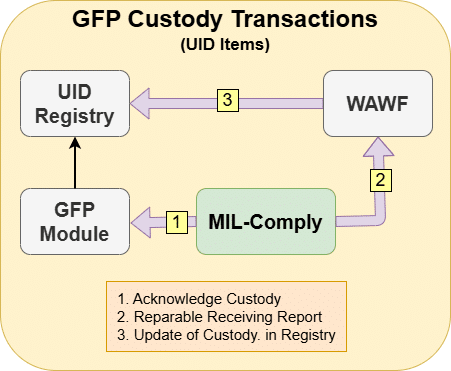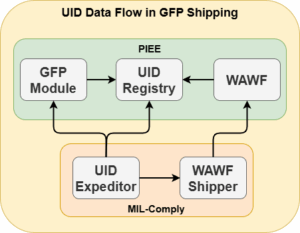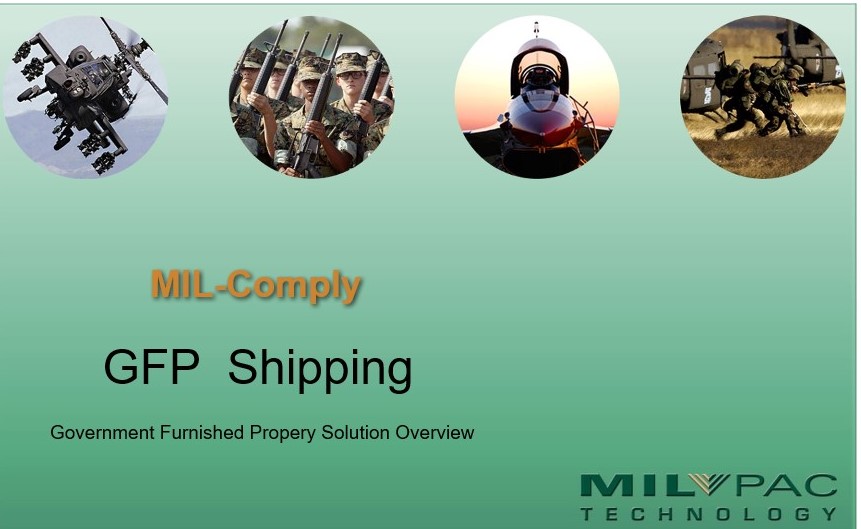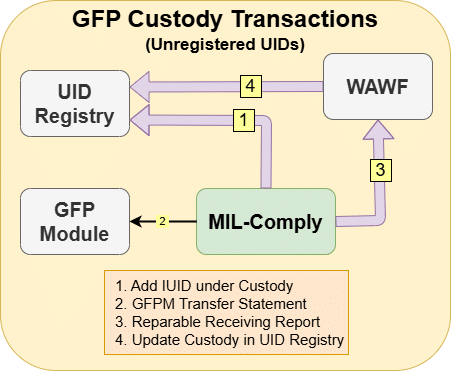UID-marked GFP items returned to the Government must be shipped on a WAWF Reparable Receiving Report (RRR) following their maintenance, repair or overhaul (MRO). The RRR itself is little different from the standard WAWF Receiving Report (DD250) that is used for shipment of new acquisition items. However, to ship GFP UID items on the RRR one must first gain custody of those items in the PIEE GFP Module (GFPM).
Why use the RRR for GFP UID Shipments?
The DFARS requires it. There is a critical difference between the standard DD250 Receiving Report and the RRR:
- Receiving Report – adds new UID items to the IUID Registry
- Reparable Receiving Report – transfers custody of existing UID items
The Reparable Receiving Report is still a DD250, it just contains additional data found only on a RRR and is marked as such. Use of the RRR is required by the DFARS for use when shipping GFP.
The challenge of shipping GFP UID items with a RRR is due to the requirement that custody of such items must first be acquired from the GFP Module (GFPM). View our GFP Shipping video for an overview of the process. Although the video was released before the 2025 GFPM mandate which replaced some Direct-To-Registry transactions, it is reflective of the overall process.
The GFP Module confirms that each item to be transferred already exists in the UID Registry. Items not found in the UID Registry must be added to it. MIL-Comply does all of this without any need to access the PIEE website.
WAWF will reject a standard Receiving Report that includes UID items which are already in the UID/IUID Registry. But it is worse to ship unregistered UID-marked GFP on a standard RR.
Shipping previously unregistered GFP items on a standard RR causes them to be added to the UID Registry by WAWF, but as new items and at the cost of servicing rather than acquisition. This is prohibited by the DFARS and could result in a corrective action request.
WAWF RRR Process for GFP UID

- Receipt/Custody of GFP items must be acknowledged to the GFP Module.
- A Reparable Receiving Report (RRR) is used instead of the standard DD250.
- GFP UID items not currently in the IUID Registry must be added first.
The MIL-Comply UID Expeditor acknowledges receipt of UID items by exchanging EDI transactions with the GFP Module. Items may be shipped as soon as all items on the EDI Transfer Statement (TS) have been acknowledged by the Government as in contractor custody. Items found not to be int the UID Registry will cause the TS to fail. The TS may be resubmitted after the unknown UID items are added to the IUID Registry. UID Expeditor handles all of this with a combination of GFPM EDI and Direct-To-Registry transactions.
Once the Government accepts a Transfer Statement its UIDs items considered to be Property in Possession of Contractor (PPC). At this point they become visible to Comply/Labeling users for generating Mil-Std-129 container labels, and to Comply/Shipper users for inclusion on a Reparable Receiving Report (RRR). They may be shipped in a single shipment (as they were received) or as they become available (after completing your MRO process). Either way, using MIL-Comply’s WAWF Shipper makes the process essentially the same as submitting DD250 Receiving Reports to WAWF for new acquisition UID items.
 Adding Items to IUID Registry
Adding Items to IUID Registry
It is very simple to add unregistered UID GFP items to the IUID Registry using UID Expeditor. They must be items which have been received under an MRO contract. It must be done as part of the Receipt process. They will be transferred to contractor custody (become PPC) when successfully added to the Registry. Refer to the GFP Module Process for more about adding GFP items to IUID Registry.
Mil-Std-129R Labeling of GFP UID Items
GFP Items shipped to the Government are generally packaged and labeled in the same manner as new items using Mil-Std-129 container labels. Comply/Labeling users will find this easy to do, the only difference being that UID items are selected for shipments out of the MIL-Comply GFP database rather than being added to the Comply UID database as new items. The same Mil-Std-129 IUID Container Labels are used for shipping both new and GFP items.
GFP Labeling and WAWF Shipment
GFP items are initially handled by the Comply UID Expeditor. They are not visible to Labeling or Shipper when they are newly received. This happens only after they reach one of these two states:
- Property in Possession of Contractor (PPC) as designated by the GFP Module when their Transfer Statement (Receipt) has been accepted by the Government.
- Ok To Ship, indicating that a PPC item has completed your MRO process and is ready for shipment. This is an additional internal process requirement that may be configured in MIL-Comply to provide additional control.
Current Part Number (Part Number Rollovers)
Part number rollovers that occur during item maintenance or upgrade result in the assignment of the new part number as the item’s Current Part Number (CPN). This is sent to the GFP Module as custody of the part is acquired (Receipt/Transfer Statement).
The new CPN is recorded in the item’s UID record in the Registry. The UII itself does not change, even if it is a Construct 2 marking based on the original part number. It remains item’s permanent identifier. The Current PN augments the UID record but does not replace the UII nor the Original PN.
A CPN label/marking is applied to the item as an additional Part Marking in accordance with Mil-Std-130.
Lifecycle Events
Lifecycle events, such as scraping or demilitarizing by a contractor will require the use of a Transfer Statement sent to the GFP Module in order to get paid for the activity and to transfer the items back to the Government when the process is complete. Change in item status is not supported by the GFPM Module (as of September 2025). MIL-Comply is currently using Direct-To-Registry transactions for this.
Compatibility with GFP Module
Starting in January 2025, the Government mandated the use of the PIEE GFP Module for handling some aspects of the GFP process that were formerly handled through Direct-To-Registry transactions.
This requires automated systems such as MIL-Comply to transact with both the GFP Module and the IUID Registry. These systems use different data channels and transaction standards, however, UID Expeditor makes the process as seamless as possible, coordinating the actions of the two systems. For more information, see GFP Module Automation.





